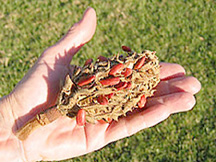Chesapeake Bay's Independent Newspaper ~ Since 1993
1629 Forest Drive, Annapolis, MD 21403 ~ 410-626-9888
Volume XVII, Issue 48 ~ November 26 - December 2, 2009
Home \\ Correspondence \\ from the Editor \\ Submit a Letter \\ Classifieds \\ Contact Us
Dining Guide \\ Home & Garden Guide \\ Archives \\ Distribution Locations \\ Advertising
![]()


|
The Bay Gardener
 by Dr. Frank Gouin |
Grow Trees and Shrubs from Seed
The time is right; here’s the secret for success
You can grow native woody plants yourself by starting them from seed. However, seed preparation and chilling temperatures are essential for these seeds to germinate in the spring.
Many seeds — dogwood, magnolia, viburnum, bayberry and holly among them — are covered with flesh. Unless the flesh is removed prior to planting, it may take two years for the seeds to germinate. The flesh covering often takes a year to rot from the seed, preventing water from initiating germination. Some of the flesh contains inhibitors, which must be completely decomposed for the seeds to germinate.

![]() Germination of such seeds can be hastened by fermenting the fleshy seeds in warm sugar water and yeast. After a few weeks of this treatment, the flesh will float to the surface, and the good seeds will sink to the bottom.
Germination of such seeds can be hastened by fermenting the fleshy seeds in warm sugar water and yeast. After a few weeks of this treatment, the flesh will float to the surface, and the good seeds will sink to the bottom.
Other fleshy seeds need special treatment. The flesh covering the seeds of magnolia is best removed by rubbing the seeds on a wire screen until the flesh separates.
The seeds of black walnuts are covered by a thick husk. The most effective treatment for removing the husk, without getting your hands purple-black, is to spread the nuts on a dirt road or driveway and drive a car over the nuts several times.
Once the seeds are clean, they must be sown in moist warm soil in the fall, soon after they have been collected. That’s because the seeds of woody plants must absorb water before the ground cools and freezes.
The seeds of woody natives also require chilling, better known in horticulture as stratification. Before most of these seeds can germinate, they require several hundred hours of chilling temperatures between 44 and 32 degrees. Stratification does not occur at temperatures below freezing. The amount of chilling required is different for each species.
Thus you don’t collect the seeds in the fall, store them in the house and plant them in the spring, as is the way with vegetable and flower seeds.
On the other hand, you can’t depend on Mother Nature to grow the seeds for you. It’s estimated that less than one percent of the seeds that fall to the ground produce a desirable plant.
So now’s the time to gather, prepare and begin your future garden of woody plants.
Ask Dr. Gouin your questions at [email protected]. All questions will appear in Bay Weekly. Please include your name and address.
© COPYRIGHT 2009 by New Bay Enterprises, Inc. All rights reserved.